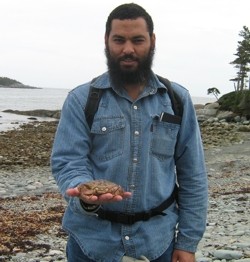Saad Mohamed

Ph. D. Thesis
MONITORING OF THE REMEDIATION OF HALIFAX HARBOUR AFTER 250 YEARS OF CONTAMINATION USING FORAMINIFERAL PROXIES
(PDF - 6.5 Mb)
The analyses of benthonic foraminifera in surface sediments for two-years (Oct. 2007-August 2009) and cores from Halifax Harbour (HH) were essential for short-term monitoring, and reference environment reconstruction for the remediation that started in 2008. The distribution of foraminifera in the surface sediments indicates a lateral environmental variation and positive correlation to the pollution rate in HH as the environmental purity increases seawards. The treated area, Inner Harbour, recorded a rapid environmental recovery during treatment period (2008), and reverted to its former characteristics after treatment stopped (early 2009). This recovery represented by an increase in both diversity (from <12 to >20 species) and abundance (from 120–880 to 1350-1750 individuals). Additionally, the assemblage during that period witnessed a decrease in opportunistic species (<50%), shell deformities (<11%), and inner linings (17%), and a significant increase in calcareous species. The assemblage in pre-impact environment, as inferred from cores, has a high diversity (>30 species) and abundance (>4000 individuals), a dominant calcareous record (>60%), and lower deformities (3-4%). The gradual environmental degradation due to organic enrichment in the harbour caused an increasing foraminiferal decimation to reach dramatic levels with the huge growth of Halifax city since late 1950s. This decimation led to dominance of opportunistic species (e.g., agglutinated forms such as Eggerella advena, and Reophax scottii), abundance of shell deformities, and complete absence of calcareous tests, leaving only their inner linings. Analysis of benthonic foraminifera in two cores from Sydney Harbour (SH) helped to compare contamination types in both areas (domestic in HH vs. industrial in SH). The domestic pollution in HH developed an agglutinated assemblage with low diversity, low abundance, and high ratios of inner linings. In SH the assemblage showed higher diversity (>22 species) and abundance (>4000 individuals), dominant calcareous record (>50%), and low inner linings (<10%) together with some species that had never been observed in such cold waters in Nova Scotia (Ammonia beccarii).
Keywords:
Pages: 218
Supervisor: David Scott



